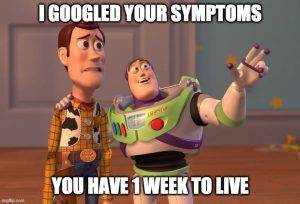In a world where your patients are just one Google search or AI chat away from diagnosing themselves with an “inevitable doom,” the need for content marketing for patient education has never been more apparent.
The internet is a goldmine of health info. It is also a breeding ground for wild misinformation. What if your practice became the trusted voice patients turn to? By sharing clear, useful content, you’re not only educating but also sending the message: “We’ve got this, and we care.” That’s how you convert frantic Googlers into loyal patients who actually stay, not the ones who vanish into WebMD-induced panic.
Jason Lim, founder of Medical Channel Asia, shares his thoughts about effective content marketing for healthcare providers to their patients.
“Patients today are not just seeking treatment; they’re searching for knowledge and guidance.”
The right content can turn frantic Google searches and AI chats into informed decisions, building trust between patients and providers long before an appointment is made. This is where content marketing steps in, offering the right balance of education and engagement to attract and retain patients.
Jump to section:
- Why Content Marketing for Patient Education Matters
- Educating Patients with Content That Builds Trust
- How Content Marketing for Patient Education Attracts New Patients
- Engaging Patients with Personalised Educational Content
- Measuring Success: How Educational Content Engages and Converts
Why Content Marketing for Patient Education Matters
Let’s be honest: healthcare is all about trust. Patients want more than just a doctor in a white coat. Content marketing for patient education gives you the chance to prove you are both knowledgeable and approachable.
Trust is the backbone of any successful doctor-patient relationship. Content marketing for patient education allows you to foster that trust before patients even walk through your door.
Here’s why it matters:
- It establishes credibility. In a sea of online medical advice (some of it more fiction than fact), your content can stand out as the reliable source. Educational content allows healthcare providers to build credibility and develop meaningful relationships with patients before they even set foot in the office. When patients trust the information you provide, they are more likely to book that first appointment.

Image credit: Medelita - It answers patients’ questions. Think about it — patients are searching for things like “Is this mole cancerous?” or “What’s the best treatment for back pain?” By addressing common questions directly on your website or social channels, you’re meeting patients where they are.
- It builds relationships before appointments. When patients come across your content online, they start to feel connected to your practice. They already know you care enough to provide valuable information for free. This trust makes the transition from reader to patient much smoother, turning them into loyal advocates of your practice.
- It reduces misinformation. Let’s face it: the internet is a breeding ground for medical myths. By sharing accurate, well-researched content, you’re actively fighting against the panic many patients experience. You’re helping them understand their health in a way that feels empowering, not overwhelming.
Digital Healthcare Marketing Conference
If you are a healthcare provider and want to learn more about digital marketing strategies for your practice, register today for the Connecting Care With Clicks Conference happening on 12 October 2024 (Saturday), for a full day of learnings and networking with industry experts in digital healthcare marketing. 8 CPD points available.
Educating Patients with Content That Builds Trust
Education is empowerment, especially when it comes to healthcare. Content marketing for patient education plays a pivotal role in helping patients understand their health and feel more in control.
Here’s how it works:
- Simplifying complex medical terms. As Lim notes, “In healthcare, one-size-fits-all doesn’t cut it. Personalised content that addresses specific patient concerns makes patients feel heard and deepens their connection with the provider.” Crafting content in plain language ensures patients understand their health, empowering them to make informed decisions.
- Providing actionable information. Patients don’t just want to know what’s wrong. They want to know what to do about it. Content that offers clear, actionable advice (like tips for managing diabetes or exercises to relieve back pain) turns readers into empowered decision-makers. The more they feel guided and informed, the more likely they are to return to your practice for more personalised advice.
- Offering preventive care tips. Patients aren’t always searching for a diagnosis. Sometimes, they just want to stay healthy. Educational content focused on prevention can help keep your patients informed and healthier. It also keeps them engaged with your practice long-term, as they come to rely on your advice to maintain their overall well-being.
- Building long-term trust. When your content consistently delivers value, patients begin to trust not just the information, but you as a provider. Over time, this relationship deepens, and patients feel more confident in your care. They’ll come to you not only when they need treatment, but when they’re seeking knowledge, knowing you’ll provide guidance they can trust.
How Content Marketing for Patient Education Attracts New Patients
While building trust with existing patients is key, content marketing for patient education is also a magnet for attracting new ones. Here’s how it pulls in potential patients:

- SEO: Your secret weapon. When patients are searching for answers, they turn to Google or ChatGPT. Optimised content ensures that when patients are searching for answers, they find your practice first. Lim highlights, “As more patients turn to digital platforms for healthcare advice, the future of marketing will belong to those who prioritise clear, patient-centric content.”
- Reaching patients through social media. Social platforms aren’t just for cat videos; they’re where patients are asking health-related questions and sharing experiences. Posting educational content on social media allows you to meet patients where they are.
- Showing authority with consistent content. Regularly publishing educational content shows you’re up-to-date with the latest healthcare trends and research. New patients are more likely to trust a doctor who is clearly engaged in their field, offering fresh, reliable information.
- Creating a welcoming digital front door. When new patients find your content online, it’s often their first interaction with your practice. A website filled with educational resources, clear answers, and a welcoming tone acts as a “digital front door,” inviting patients to step in. Content that provides value and guidance from the get-go can turn a casual reader into someone who is ready to schedule an appointment.
Read more: Top Factors Patients Consider When Choosing Their Doctor
Engaging Patients with Personalised Educational Content
One-size-fits-all doesn’t work in healthcare, and it doesn’t work in content marketing either. Content marketing for patient education works best when it’s tailored to individual needs. Here’s how personalising your content keeps patients engaged:
- Catering to different patient groups. Your patients aren’t all the same — neither should your content be. Customise your content to speak directly to their needs. When patients feel that your content is relevant to them, they’re far more likely to stay engaged.
- Using patient feedback to refine your approach. Want to know what content will engage your patients? Ask them! Patient surveys and social media comments can provide invaluable insights into the topics they care about most. Use this feedback to create more focused content that answers their specific concerns.
- Segmenting your content delivery. Not every patient wants to read about the latest developments in joint replacement surgery. That’s where content segmentation comes in. By dividing your audience into based on demographics, conditions, or interests, you can deliver more relevant content.
- Keeping patients engaged. After a patient visits your practice, your content strategy doesn’t stop there. Sending personalised follow-up emails with additional resources or wellness tips helps to maintain the relationship. This builds loyalty and keeps patients returning for care.
- Creating interactive, patient-driven content. Interactive tools, like symptom checkers or health quizzes, are powerful ways to engage patients. They allow patients to explore their health concerns actively. When patients feel involved in their own care, they feel more engaged and they are more likely to return for future consultations.
Measuring Success: How Educational Content Engages and Converts
Creating valuable content is only half the battle. To truly benefit from content marketing for patient education, you need to measure its impact. Here’s how to track what’s working, and what’s not:
- Tracking website traffic and engagement. The first indicator of success is how much traffic your educational content drives to your website. Tools like Google Analytics can show how many people are visiting, what pages they’re reading, and how long they’re staying. High engagement and conversion rates are key indicators that your content is hitting the mark.
- Monitoring patient conversions. Traffic is great, but conversions are where the magic happens. Are readers booking appointments after consuming your content? Tracking conversions helps you understand which pieces of content are actually driving patient through the door.
- Assessing content-specific performance. Not all content will perform equally, and that’s okay. The key is figuring out what works best for your audience. Do videos get more engagement than written articles? Are your social media posts pulling in more traffic than email newsletters? By reviewing individual content performance, you can double down on the formats and topics that resonate most with your patients.
- Collecting patient feedback. Sometimes the best insights come directly from your patients. Do they feel better informed? Have they followed through on preventive care tips from your content? Patient feedback is invaluable for fine-tuning your approach and ensuring you’re providing real value. You can use surveys or even casual conversations to find such information.
- Iterating and improving. The world of digital content is never static. Keep an eye on trends in patient behaviour and health concerns, and continuously update your content to reflect what your patients care about most. The more you improve, the more you’ll engage and convert.
Turning Educational Content into Long-Term Patient Relationships
Content marketing for patient education isn’t just about pushing information, it is about building trust, attracting new patients, and keeping them engaged with your practice. By tracking how your content performs, you ensure it delivers real value and continues to grow your patient base.
As Lim notes, “The practices that provide value through education will be the ones that thrive.” By empowering patients with knowledge, your practice isn’t just attracting more visits. It is fostering deeper connections and building a reputation that lasts.
Read next:



